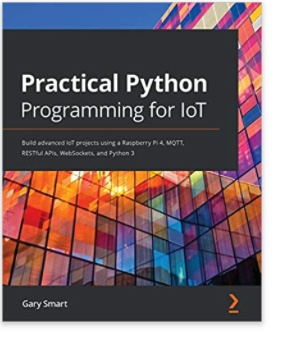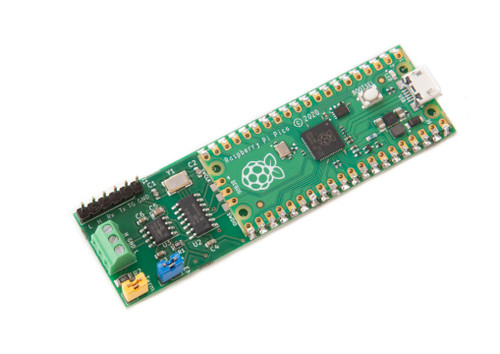Blog
Recent Posts
Advanced IoT Programming Using The Raspberry Pi 4 And Python 3
Posted by on
Python is an interpreted, object-oriented, high-level programming language with dynamic semantics. Its high-level built-in data structures, combined with dynamic typing and dynamic binding, made it very attractive for Rapid Application Development. It is used as a scripting or glue language to connect existing components.
Python's simple, easy-to-learn syntax emphasizes readability and therefore reduces the cost of program maintenance. Python supports modules and packages, which promotes program modularity and code reuse. The Python interpreter and the vast standard library are available in source or binary form without charge for all major platforms and free distribution.
Practical Python Programming for IoT consists of three parts, starting with IoT's "Internet" component. First, the reader explores an IoT application development to control an LED over the internet before discovering how to create RESTful APIs, WebSocket APIs, and MQTT services in Python.
The second part examines the fundamentals behind electronics and GPIO interfacing. As the reader progresses to the last detail, the focus shifts to IoT's "Things" aspect, i.e., connecting and controlling various electronic sensors and actuators using Python. The book also explores multiple further topics, such as motor control, ultrasonic sensors, and temperature measurement.
Lastly, the book introduces advanced IoT programming techniques to integrate IoT visualization and automation platforms and build a complete IoT project.
By the end of the book, the reader will be well-versed with IoT development and own the knowledge to build advanced IoT systems with Python.
Table of Contents
- Setting Up your Development Environment
- Getting Started with Python and IoT
- Networking with RESTful APIs and Web Sockets using Flask
- Networking with MQTT, Python, and the Mosquitto MQTT Broker
- Connecting Your Raspberry Pi to the Physical World
- Electronics 101 for the Software Engineer
- Turning Things On and Off
- Lights, Indicators, and Displaying Information
- Measuring Temperature, Humidity, and Light Levels
- Movement with Servos, Motors, and Steppers
- Measuring Distance and Detecting Movement
- Advanced IoT Programming Concepts – Threads, AsyncIO, and Event Loops
- IoT Visualisation and Automation Platforms
- Tying It All Together - An IoT Christmas Tree
CANPico - CAN FD Module With Raspberry Pi Pico
The CANPico module is a carrier board for the Raspberry Pi Pico. It is soldered onto the Pico, connecting the Raspberry Pi to a CAN Bus controller and transceiver, ready for connection to a CAN Bus network via a simple screw terminal.
The CANPico includes an instrument header with the CAN H and CAN L signals and the digital RX and TX signals with an oscilloscope or logic analyzer. Software support is via an open-source MicroPython SDK.
Sensor Networks with XBee, Raspberry Pi, and Arduino: Sensing the World with Python and MicroPython
This book explains how to build sensor networks with Python and MicroPython using XBee radio modules, Raspberry Pi, and Arduino boards. This revised and updated edition will put all of these technologies together to form a sensor network and show you how to turn your Raspberry Pi into a MySQL database server to save sensor data. The reader [...]
Raspberry Pi 4 Step-By-Step Guides To Innovative Linux Projects
RASPBERRY PI 4 COMPLETE MANUAL: A Step-by-Step Guide to the New Raspberry Pi 4 and Set Up Innovative ProjectsThe Raspberry Pi 4 can accomplish a remarkable variety of embedded applications. Amateur technology enthusiasts use Raspberry Pi boards as media centers, file servers, retro games consoles, routers, and network-level ad-blockers, for starters. However, that is just [...]
USB-to-CAN Gateway With Isolated CAN Bus Port Supports Programming In C, C#, Python
IXXAT, a subsidiary of HMS Networks, has introduced their USB-to-CAN adapter called SimplyCAN, which allows the diagnosis, configuration, and commissioning of devices and systems operating in a CAN Bus network via an API without the need for driver installation.The CAN Bus gateway is suitable for mobile and stationary use. The CAN Bus port is galvanically isolated and accessible [...]
PICAN2 - Raspberry Pi CAN Bus HAT Supports SocketCAN and Python Programming
The PICAN2 board provides Controller Area Network (CAN) Bus capabilities for the Raspberry Pi. It uses the Microchip MCP2515 CAN controller with MCP2551 CAN transceiver. The CAN Bus connection is via DB9 or 3-way screw terminal. The board is also available with a 5 VDC 1 Amp SMPS (Switch Mode Power Supply) that can power the Raspberry Pi via [...]
Thermocouple Measurement HAT Adds Industrial Temperature Measurement To The Raspberry Pi Platform
Measurement Computing Corporation has announced the release of their MCC 134 thermocouple measurement HAT for Raspberry Pi. The MCC 134 brings industrial temperature measurement capabilities to the vastly popular Raspberry Pi platform. The device comes with four thermocouples (TC) inputs capable of measuring popular TC types, such as J, K, R, S, T, N, E, and B. [...]
Python Hands-On Guide For Writing Effective And Idiomatic Code
Python’s ease-of-use supports every engineer to become productive instantly, but this usually implies that they are not using all the features it has to offer. With this hands-on guide, you discover how to write robust, idiomatic Python code by leveraging its best, and probably most overlooked features. Author Luciano Ramalho takes the reader through Python’s core language features [...]
Use Powerful Python Libraries To Implement Machine Learning And Deep Learning
Machine learning is starting to dominate the software world, and now deep learning is reaching machine learning. Experience and perform at the cutting edge of machine learning, neural networks, and deep learning with this second edition of Sebastian Raschka's bestselling book, Python Machine Learning. Thoroughly updated using the latest Python open source libraries, this book offers useful [...]
Raspberry Pi Cookbooks For Python Programming Plus Software and Hardware Solutions
With millions of new users and several new models, the Raspberry Pi ecosystem continues to grow, along with new questions about the Raspberry Pi’s capabilities. The second edition of this favorite cookbook provides more than 240 hands-on recipes for running this small, low-cost computer with Linux, programming it with Python, and hooking up sensors, motors, and [...]
Recipe-Based Guide To Programming Your Raspberry Pi 3 Using Python
This book begins by leading you through setting up Raspberry Pi 3, performing tasks using Python 3.6, and introducing the first steps to interface with RPI peripherals. As you work through the chapters, you will develop your skills and apply them as you advance. You will learn how to build text classifiers, predict sentiments in words, develop applications [...]
 Loading... Please wait...
Loading... Please wait...


